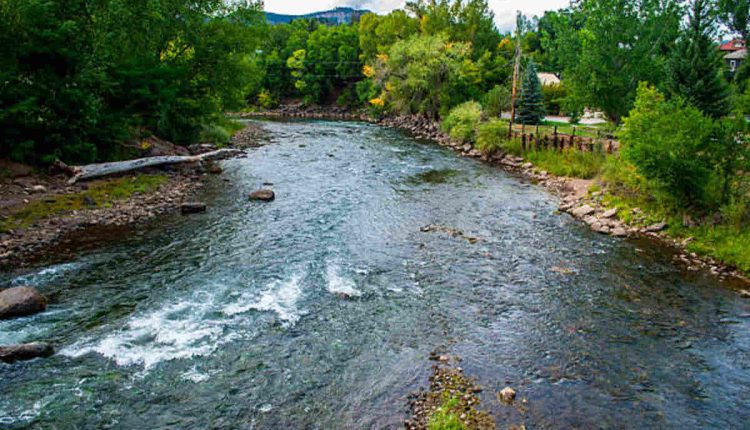Animas River Streamflows
The Animas River snakes its way from Silverton through Durango before reaching New Mexico’s San Juan River. A favorite among expert kayakers and whitewater enthusiasts alike, its once pristine condition allowed residents to swim, fish, and even use its waters for irrigation purposes.
Water Rights
While water quality falls under the purview of the federal Clean Water Act, water rights are managed at a state level. Colorado’s system for administering water rights relies on “prior appropriation.” Under this principle, those with an intent to divert a certain quantity can secure conditional rights if they act responsibly in undertaking their project.
Senior water rights holders have more rights than junior holders to divert more water from natural streams, though seasonal and year-to-year fluctuations affect this practice. Therefore, Durango strives to utilize its raw water supply from Florida and Animas rivers as efficiently as possible.
The Animas River begins its journey in alpine waters near Silverton, Colorado, before winding its way across arid landscapes and ending up at Farmington in New Mexico. Unfortunately, decades of mining activity left behind pollution along its route, so this river needs our support in its healing journey.
Proponents of the Animas-La Plata Project (A-LP) contend it will capture abundant spring water to help rinse farms in an arid region and secure drinking water for towns and residents, but critics of this scheme assert it will degrade water quality, disrupt elk herds, as well as pose other environmental and ecological threats.
Hydroelectric Power
Every spring, as the snow melts from the San Juan Mountains, the Animas River surges with unprecedented water flow – known as “peak flow.” While rafters and other river enthusiasts alike enjoy this “peak flow” event, its effect can also pose environmental threats.
High water levels in the upper reaches of the Animas River make survival challenging for fish and may increase metal contamination levels in the river, while warmer water temperatures compound existing conditions like nutrient pollution and bacteria inflow, negatively affecting aquatic life.
Hydroelectric power is one of the most cost-effective energy sources, producing up to 90% of its electricity from water alone. Unlike solar and wind power systems that require frequent stops and starts in order to maximize production, hydroelectric plants operate continuously.
Hydroelectric power poses environmental threats in addition to mining; dams limit oxygen in waterways, harming wildlife and plant life downstream, and carbon dioxide and methane emissions from hydroelectric plants can harm aquatic vegetation in general. Yet hydroelectricity remains an integral part of global energy mixes, and measures have been put in place to minimize any negative consequences associated with its usage.
Recreation
The Animas River provides locals and visitors alike with an invaluable recreational resource, whether they enjoy boating, swimming, fishing, or just splashing around in its waters. Its picturesque setting makes the Animas an attractive tourist destination and allows residents to relax outdoors with friends or family members.
Recreational activities can have an adverse impact on river health, which is evident through changes to metals and E. coli levels. Rafters, kayakers, and tubers could become sick from swallowing water or sediment accidentally, and consequently, the Environmental Protection Agency has developed screening levels for recreational exposure to metals and bacteria.
As the EPA works on short-term solutions such as holding ponds and improving wastewater treatment at Santa Rita, Dvorak noted it will be challenging to address long-term metal pollution in river water and sediment. “That process will likely involve political considerations,” he stated; calls for steps such as Superfund designation or good Samaritan laws are unlikely to gain much traction due to such politics.
Dvorak noted that creating new recreational opportunities could help the river’s ecosystem as well. Promoting more river recreation disperses heavy usage over multiple sites, thus mitigating any one impact point and inspiring advocacy efforts to preserve healthy waters.
Fishing
The Animas River is a Gold Medal fishery offering rainbow, brown, and Colorado River cutthroat trout species. The river has long been recognized for producing large fish – it was even home to an 18-pound brown trout, which once set state-record status! Popular among fly fishermen and crowds in Durango alike.
Fishing on the river relies heavily on its flow, which varies with each season and year. Winter and spring usually see lower river flows, while higher flows occur during the summer and fall seasons. Since the Animas River is a freestone river system, its waters depend on natural sources for freshwater supply.
Runoff from the 416 Fire burned into the river in July and caused a widespread fish kill due to low oxygen levels that reduced fish respiration and ultimately led to their deaths. Thanks to several rainfall events this week, however, wildlife officials are optimistic that its waters may rebound quickly.
Fly fishing the Animas River is an enjoyable year-round activity, though certain seasons and patterns offer tremendous success. Midges tend to dominate early in the season, while caddisflies become dominant later. A Pale Morning Dun hatch often occurs in late summer; for this period, a pale-bodied fly such as Light Cahill or Specialized Pale Morning Dun pattern should prove effective.
Anglers may use nymphs and streamers, depending on the season. Brown trout are most prevalent from mid-October to mid-November on the Animas River. A 9′ 5-weight rod works best here, along with neoprene chest-high waders and padded wading staff; additionally, a Riversmith rod roof rack should also be brought.

